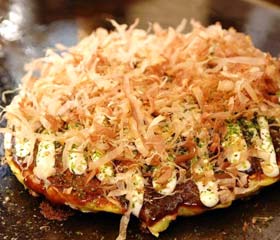
Okonomiyaki.
Osaka, with a population of 2.64 million, is widely regarded as Japan's unofficial second city after Tokyo. Situated somewhat west of the center of Honshu and lying on Osaka Bay, it is the economic hub of western Japan. Since the Edo period (1603-1868) this city has developed as a port where foodstuffs from all across Japan are shipped for distribution. This has made it the site of fierce competition among restaurants and earned it the nickname kuidaore no machi, or "the city where you eat ‘til you drop." Osaka has no shortage of cheap but delicious eateries. The Dotonbori area, in particular, with its cornucopia of restaurants and the flashy displays for which it has become famous, is always abuzz with people seeking to fill their epicurean desires.
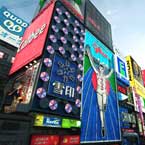
Dotonbori, famous for glitzy neon signs. (C)Osaka Prefecture
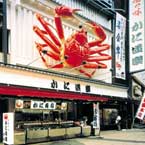
The display of Kani Doraku, a restaurant in Dotonbori serving crab.
Food for the Masses
The two popular foods most associated with Osaka are okonomiyaki and takoyaki. Flour-based dishes like these are known as konamon (flour food) in the dialect of the Kansai region, of which Osaka is the largest city. Okonomiyaki are thick, savory pancakes, and Osaka-style okonomiyaki features batter mixed with such ingredients as shredded cabbage, egg, squid, pork, and beef. The mixture is generally cooked before your eyes on a griddle built in to each table. Once cooked, the okonomiyaki is topped with a thick sauce made by adding vinegar, sugar, and spices to a vegetable and fruit broth, as well as with mayonnaise, katsuobushi (dried bonito shavings), and aonori (green laver). Although waiters commonly cook for customers at the table, it is also fun to try cooking okonomiyaki yourself.

Takoyaki. (C)Osaka Prefecture
Takoyaki are a simple snack that can be either bought at a stall or cooked at home. A batter of egg, flour, and kelp and bonito stock is poured into a special griddle with semispherical indentations, and octopus pieces, tenkasu (bits of deep-fried batter), pickled ginger, and spring onion are added. The cook makes the mixture into balls by repeatedly turning it as it cooks in each of the indentations. Like okonomiyaki, takoyaki are eaten with sauce, mayonnaise, and bonito shavings. The surface should be crisp, the inside moist, and the octopus firm.
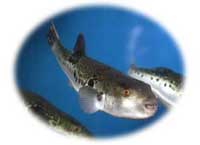
Fugu, or puffer fish. (C)Genpin Fugu
Puffer Fish: Delicious but Poisonous
Another Osaka favorite is fugu, or puffer fish. Dishes to be found at fugu restaurants include tessa and tecchiri. Tessa is fugu sashimi, sliced so thin that the patterns on the plate show through. Dipping it in a sour sauce called chirisu - made by mixing together the juice of sudachi or other citrus fruit, vinegar, soy sauce, mirin (sweet rice wine), and bonito shavings - enhances the sashimi's light flavor. Tecchiri, meanwhile, is a kind of hot pot. The bony parts of the puffer fish are first simmered in kelp broth, to which vegetable and tofu are added. Finally, pieces of fugu meat are waved back and forth in the soup using chopsticks until they are half-cooked.
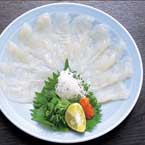
Fugu dishes. (C)Genpin Fugu
Although fugu meat is known for its delicate taste, the fish contains a deadly toxin. Even a tiny amount of the poison can be lethal if ingested, so only chefs who have been specially licensed to remove the toxic parts are allowed to prepare fugu.
The Secret Is in the Stock
The excellence of Osaka foods owes much to the skillful use of stock as a base for various flavors. Osaka has historically been blessed with the bounties of both the sea and the land, and this has allowed the city's inhabitants to conjure up a variety of broths from different ingredients for different dishes. According to Kumagai Mana, the representative of the Nippon Konamon Association and a food culture expert, "In Osaka the basic stock is made from kelp, and shavings of dried bonito, mackerel, or sardine are added, depending on the food being prepared, to make the stock more rich and mellow. When dining in Osaka, I hope visitors will note the deep flavor of the stock contained in the takoyaki and okonomiyaki batter, tecchiri, and other dishes."
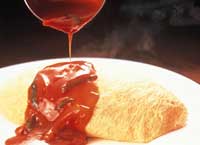
Omuraisu. (C)2006 Hokkyokusei Sangyo Inc.
Osaka is also home to many high-caliber but affordable restaurants offering Yoshoku (Western-style fare specially arranged for Japanese tastes), such as Japanese-style curry with rice and hayashi-rice (Japanese-style hash with rice). The restaurant that invented omuraisu, now a popular dish nationwide, is located in Osaka. Omuraisu, or rice cooked with chicken and ketchup wrapped in a fluffy omelet and topped with tomato sauce, is favored across Japan for its homely taste.
|






